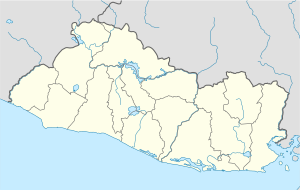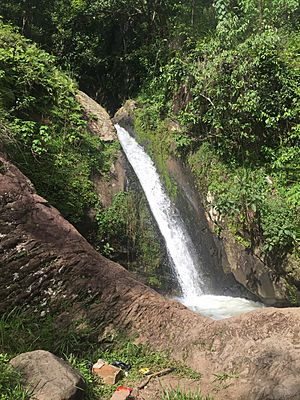La Laguna, El Salvador facts for kids
Quick facts for kids
La Laguna
|
|
|---|---|
|
Municipality
|
|
| Country | |
| Department | Chalatenango Department |
| Area | |
| • Total | 9.97 sq mi (25.82 km2) |
| Elevation | 3,369 ft (1,027 m) |
| Population | |
| • Total | 5,240 |
| • Density | 525.6/sq mi (202.94/km2) |
La Laguna is a small town and municipality located in the Chalatenango area of El Salvador. It's a place with a rich history and beautiful natural spots.
Contents
About La Laguna
La Laguna covers an area of about 25.82 square kilometers (about 10 square miles). In 2006, around 5,240 people lived there. This means about 203 people lived in each square kilometer.
How La Laguna is Organized
The municipality of La Laguna includes its main town area and several smaller villages called cantons.
- La Laguna (main town)
- La Cuchilla
- Pacayas
- Los Prados
- Plan Verde
- San José
The main town of La Laguna is divided into smaller neighborhoods called barrios:
- Barrio El Centro
- Barrio Las Victorias
- Barrio Los Guevara
- Barrio Las Delicias
History of La Laguna
The story of La Laguna began a long time ago. In 1807, the area was known as Loma Lisa or Santiago. Then, in 1816, it became a village and was named La Laguna.
Over the years, La Laguna belonged to different departments in El Salvador. From 1824 to 1835, it was part of the San Salvador department. Later, it joined the Cuscatlán department in 1855, before finally becoming part of the Chalatenango department, where it remains today.
Challenges and Rebuilding
On August 14, 1845, a sad event happened when Honduran forces burned down the town. Because of this disaster and health concerns, the people decided to move to a new location, which they called "Old Village site."
La Laguna also played an important role during the Salvadoran Civil War in the 1980s. Its strong adobe houses, with walls 60 centimeters thick, protected the people from bullets. A mountain called La Montañona was a key spot during the war. From its top, people could see the whole area and watch for movements. Hidden tunnels, called "tatus," were used by soldiers, and a secret radio station, Farabundo Martí Radio, operated there.
After the war ended with peace agreements, La Laguna began to heal and grow. It started to become a popular place for tourists to visit and enjoy its beauty.
Local Leaders and Progress
One important person from La Laguna was Don Luciano Calles. He was the mayor in 1972 and later served in the country's government in 1976. During his time as mayor, many improvements were made. For example, a sewage system was built, which was very advanced for the time. A health clinic was also built with help from an organization called FOCCO.
Today, La Laguna is a charming and active town. It is known for its strong community spirit and new ideas. The mayor, Baltazar Elias Galdamez, says that La Laguna is a great example for other towns. It focuses on including everyone in the community and protecting the environment.
Religion in La Laguna
Most people in El Salvador identify as Catholic. However, in recent years, other Christian religions have become more popular. La Laguna is no different, with several churches representing different faiths.
Churches you can find in La Laguna include:
- Iglesia Católica (Catholic Church)
- Tabernáculo Bíblico Bautista Amigos de Israel (Bible Baptist Tabernacle Friends of Israel)
- Asambleas de Dios (Assemblies of God)
- Iglesia Apostólica de la Fe en Cristo (Apostolic Church of Faith in Christ)
- Iglesia Pentecostal Unida (United Pentecostal Church)
Local Economy and Production
Farming and Livestock
Historically, the main crops grown in La Laguna were beans, corn, and sorghum. However, due to challenges in farming, many people started raising animals or moved to the United States for work. Because of this, the town's strong connection to traditional farming has changed. Most of what is grown now is for families to eat. If extra food is produced, it is sold through middlemen or directly to buyers.
Today, La Laguna is looking to the future with new farming methods. People are growing fruits, vegetables, and coffee using modern technologies. They are also working on beekeeping (raising bees for honey) and fish farming, which are important for the local economy.
Traditional Food and Drinks
The traditional food in La Laguna is delicious and often made with fresh, local ingredients. Common meals include beans, tortillas, meat from farm animals, soups, sweets, and seeds.
Here are some special dishes you might find:
- Pisque's famous tamales: These tamales are made from yellow corn dough cooked with ash. They are wrapped in vegetable leaves and include ingredients like salt, egg, and whole beans.
- Tenquiques: These are edible mushrooms that grow on Guachipilin trees.
- Totopostes: This is a type of bread made with lard and salt dough. They can be cooked on a griddle or in an oven and can last for up to a month. They were often called "travelers' food" because people would take them on long journeys, especially when going to pick coffee or for business in Honduras.
- Chaparro (liquor): This is a homemade drink made by fermenting water, brown sugar, pineapple, ginger, nances (a type of fruit), cinnamon, and other fruits. It is then cooked to create a strong brandy.
- Pork envinagrado: This dish is made with pork, onion, pepper, salt, annatto, tomato, and oregano. It is left in vinegar for three to four days before being cooked or fried.
- Pupusas peasant or Cupas: These are like folded tortillas, similar to empanadas.
- Pupusas with special fillings: You can find pupusas filled with chipilin (a leafy green), lorocos (an edible flower), or white sheet (quilite, another type of leafy green).
Many of the ingredients for these traditional foods come from the local area. This helps keep the local plants and animals healthy. However, people are starting to eat more processed foods, which can affect their health.
Places to Visit
La Laguna and its nearby villages offer many interesting places for visitors.
Here are some popular spots:
- La Montañona: This is a large mountain covered in oak and pine trees. It's a historic and national park, important for its natural beauty and its role in the civil war.
- Las Pacayas Waterfall: You can find a beautiful stream and freshwater waterfall in the village of Las Pacayas.
- The Sumpul River: Located north of La Laguna, this river forms part of the border between Honduras and El Salvador.
- El Cerrito de la Virgen de Fatima: A hill dedicated to the Virgin of Fatima.
- El Cajon or Blade Pond: This famous pond is found in the Honda creek, located in Canton La Cuchilla.
- A resort in El Cerrito: Near the Cerrón Grande Reservoir, there is a place to relax and enjoy the water.
- The Central Park of La Laguna: A nice spot in the middle of town where people gather.
- La Casona de La Montañona: A historic house on La Montañona mountain.
- Piedra del Cristo: In La Cuchilla, there's a deep ravine about 150 meters (nearly 500 feet) deep. Local stories say that a mythical creature called El Cipitío appears there. You can also find the remains of a plane that was shot down during the Salvadoran Civil War, and one of its wings now serves as a bridge over the ravine.
Local Crafts and Products
La Laguna is known for its traditional crafts. In the past, people made things like horse riding gear (rigging), flowers, and toys such as whistles, spinning tops, and kites. While these crafts are not as common in town today, some people still know how to make them.
You can also find people who make delicious sweets from coconut, sugar, dried fruits, and guava.
During the months of January to March, sugar cane mills are very busy. Here, sugar cane is processed into various tasty products like cachaça (a type of liquor), clear sugar, table honey, marshmallows, smoothies, and sweet brown sugar. They also make cooked pumpkins in honey.
Municipal Services
Education
La Laguna has several schools to help young people learn:
- The main town has schools up to high school (Bachelor's degree).
- Two cantons offer education up to 9th grade.
- Two other cantons provide education up to 6th grade.
- One canton has education up to 3rd grade.
Water Supply
Most of La Laguna has access to water. However, one canton and one small village still do not have drinking water. The quality of the water can also be improved. Efforts are being made to bring better drinking water to two cantons in the municipality.
Electricity
Almost all of La Laguna has electricity. Only one canton still needs to be connected to the power grid.
See also
 In Spanish: La Laguna (El Salvador) para niños
In Spanish: La Laguna (El Salvador) para niños



